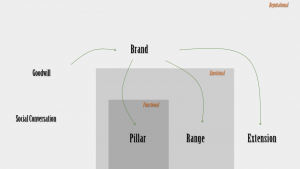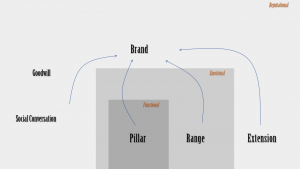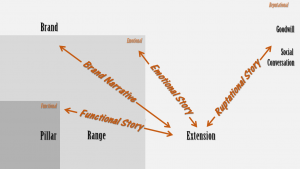BRAND NARRATIVE STRETCHING
Brand stretching is of pivotal importance for brands. Because of the way stretching is developed traditionally, through product innovation, the brand stretching narrative structure is often looked at last in the process, if it is considered at all. We believe it is both a risk and a missed opportunity. Great story telling is actually required for successful brand stretching, it is also a formidable lever for stronger stretches.
Brand stretching is a very challenging task for marketers. Stretch too far, and the brand is diluted. Stretch too little, and the new variant doesn’t get a life of its own. Modern brands also need to take into account their new reputational perimeter: brands of today gain a reputation from the goodwill they create on their name through their societal and environmental purposes as well as the values they share with customers, communities and society. Their reputation is also the result of the conversations that happen in social media on their goals, ethics and products. This has become another layer of complexity for brand stretching, because inadequate stretching is not only a business risk, but also a reputational one.
Below are the building blocks of brands in today’s world: strong brands are often built on the relevance of a pillar product, with a strong functional benefit, and a strong emotional territory. A range can extend the portfolio. In general, ranges remain consistent with the brand’s emotional territory, although functional benefit tweaks may be needed to accommodate their functionality. Brands may consider “extensions”, i.e. products or services that extend both the functional and emotional territories. However, because of the increasing role of goodwill and social conversations, extensions must remain within the “reputational” realm of the brand.

Traditionally, trust has been a determining asset that brands bring to their products, and a key reason to stretch brands, so that extensions benefit from the brand’s trustworthiness. In today’s world, trust is largely built through the goodwill the brand creates, e.g. community relationships, social and environmental responsibility programs, etc. It is crucial extensions be consistent with the goodwill narrative.

Brand likeability used to come primarily from product appeal, the enjoyment consumers had with product experience. But today, likeability is also built, evidently, through social media. It is therefore very important that extensions are consistent with positive social conversations.

In order to ensure brand stretching consistency, we look at the way in which different narratives can be intertwined. We call this the narrative flow:
- What is the brand reputational narrative? What is the goodwill narrative? How is it told? What is the social media story?
- What are the current emotional and functional narratives? What are the products’ stories? How are they brought to life?
- And of course, most importantly, what is the brand’s foundational narrative? What is the narrative frame that underpins all the brand does?

We look at the extension’s narrative and establish, firstly, whether it is consistent and incremental vis-à-vis the brand narrative. Secondly, how it fits with the reputational narrative and amplifies it. Lastly, how it resonates with existing products’ stories.
The key questions are:
- What are the narrative elements that will make the extension’s story flow seamlessly from the brand story?
- How can the extension amplify our reputation?
- How will the emotional story enhance the emotions attached to using our brand?
From a narrative point of view, Brand stretching is a similar task to creating sequels in cinema. Too close a story will leave viewers with a sentiment of déjà vu. Too far off will make viewers miss the core franchise appeal.
When Ridley Scott decided to direct Alien Covenant, he undoubtedly wanted to walk away from the latest Alien narratives, and play with the other universes he has created, such as in Prometheus. Alien’s narrative is about a face to face combat between humans and monsters, but Scott wanted to bring in a new form of evil, a deranged promethean Artificial Intelligence. So, how do you make an Alien sequel whilst evolving it? You need to make sure that it remains, quintessentially, an Alien movie. Ridley Scott came up with a very simple solution: show the Monster plainly, which previous Directors had forbidden themselves to do. There is no doubt the Alien is Alien’s foundational narrative; no doubt either that the Alien bears the brand’s reputation; that the Alien crystalizes the emotions the saga makes us experience. And the Alien’s function couldn’t be, huh, clearer.

